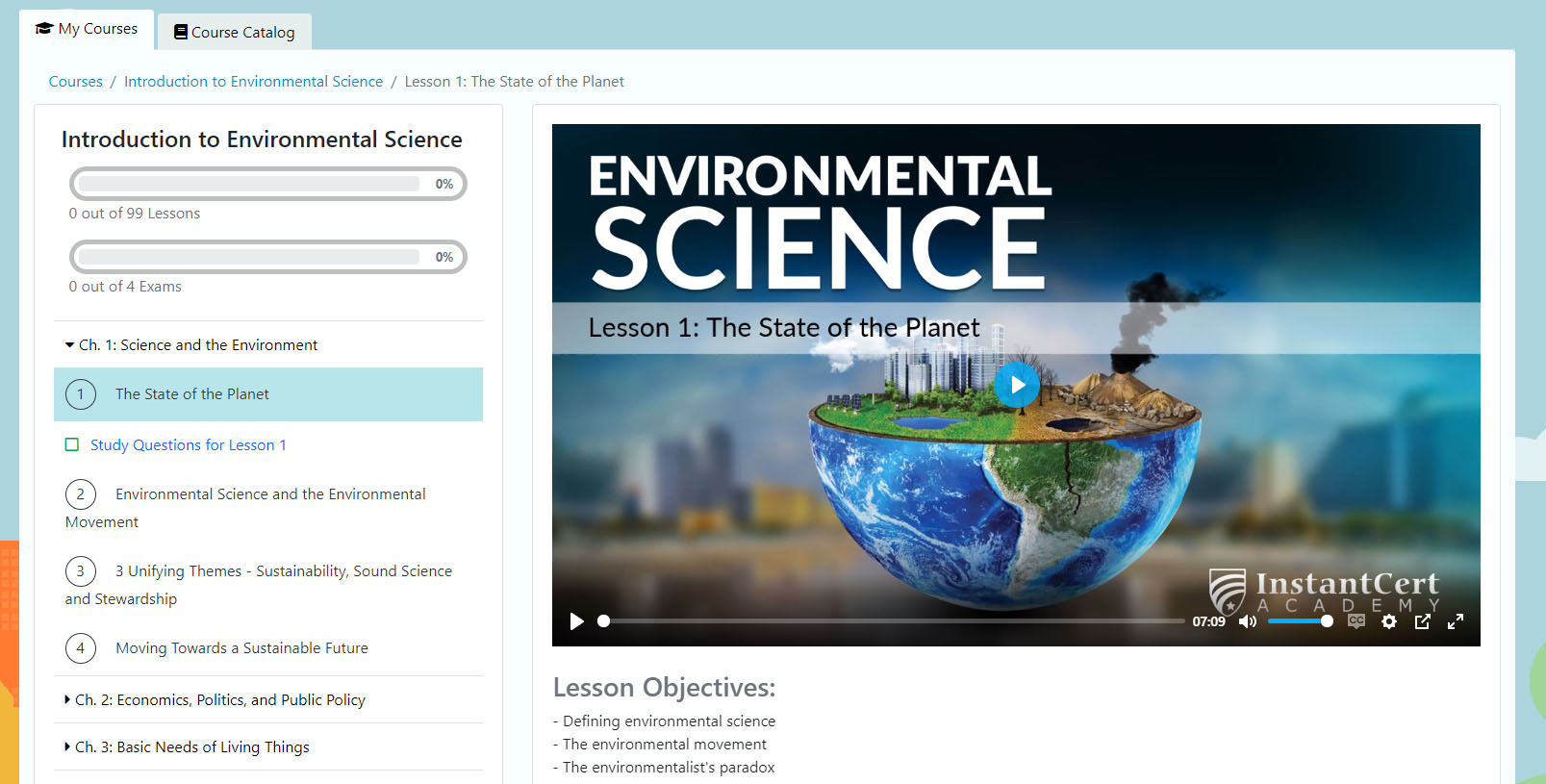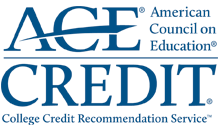InstantCREDIT Course
Introduction to Environmental Science

This course provides a general introduction to the historical and current status of the environment, with a focus on the most urgent conservation, environment, and pollution issues we face today. It provides the foundation for the study of the natural world, helping to identify and define sustainability, encourage stewardship of the environment, and educate the population through use of sound science.
At a Glance
Course Value: 3 Credit Hours
Course Level: Lower-Level Undergraduate
Course Length: 99 lessons
🗎 Download Syllabus in Word Format
Course Level: Lower-Level Undergraduate
Course Length: 99 lessons
🗎 Download Syllabus in Word Format
Course Outline
Click on a chapter name below to expand and see the lessons contained in that chapter.
Ch. 1: Science and the Environment- 2: Environmental Science and the Environmental Movement
- 3: 3 Unifying Themes - Sustainability, Sound Science and Stewardship
- 4: Moving Towards a Sustainable Future
- 6: Resources in a Sustainable Economy
- 7: Environmental Public Policy
- 8: Benefit-Cost Analysis of Environmental Public Policy
- 9: Politics and the Environment
- 11: Environmental Factors
- 12: Matter in Living and Nonliving Systems
- 13: Matter and Energy
- 14: The Cycling of Matter in Ecosystems
- 16: Limits on Population
- 17: Community Interactions
- 18: Evolution as a Force for Change
- 19: Implications for Human Management
- 21: The Flow of Energy in Ecosystems
- 22: From Ecosystems to Global Biomes
- 23: Ecosystem Responses to Disturbance
- 24: Human Values and Ecosystem Sustainability
- 26: Biodiversity and Its Decline
- 27: Saving Wild Species
- 28: Protecting Biodiversity Internationally
- 30: Consumption and Production
- 31: Biomes and Ecosystems Under Pressure
- 32: Protection and Restoration
- 34: Population and Consumption: Different Worlds
- 35: Consequences of Population Growth and Affluence
- 36: Projecting Future Populations
- 38: Promoting Development
- 39: A New Direction: Social Modernization
- 41: Hydrologic Cycle: Natural Cycle, Human Impacts
- 42: Water: Getting Enough, Controlling Excess
- 43: Water Stewardship: Supply and Public Policy
- 45: Soil Degradation
- 46: Soil Conservation
- 48: From Green Revolution to Gene Revolution
- 49: Food Distribution and Trade
- 50: Hunger, Malnutrition, and Famine
- 51: The Future: Feeding the World as We Approach 2030-2050
- 53: Chemical Treatment: Promises and Problems
- 54: Alternative Pest Control Methods
- 55: Making a Coherent Plan
- 56: Pests, Pesticides, and Policy
- 58: Exploiting Crude Oil
- 59: Drilling for Natural Gas
- 60: Mining Coal
- 61: Energy Policy
- 63: How Nuclear Power Works
- 64: The Hazards and Costs of Nuclear Power Facilities
- 65: More Advanced Reactors
- 66: The Future of Nuclear Power
- 68: Putting Solar Energy to Work
- 69: Indirect Solar Energy
- 70: Renewable Energy for Transportation
- 71: Additional Renewable Energy Options
- 72: Policies for Renewable Energy
- 74: Pathways of Risk
- 75: Risk Assessment
- 77: Climate Change Science
- 78: Response to Climate Change
- 80: Major Air Pollutants and Their Sources
- 81: Impacts of Air Pollutants
- 82: Bringing Air Pollution Under Control
- 83: Destruction of the Ozone Layer
- 85: Wastewater Treatment and Management
- 86: Eutrophication
- 87: Public Policy and Water Pollution
- 89: Better Solutions: Source Reduction and Recycling
- 90: Public Policy and Waste Management
- 92: Hazardous Waste Disposal
- 93: Cleaning Up the Mess
- 94: Managing Current Toxic Chemicals and Waste
- 95: Hazardous Chemicals: Pollution and Prevention
- 97: Urban Blight
- 98: Moving Towards Sustainable Cities and Communities
- 99: Lifestyles and the Common Good
Course Requirements
All of our courses are scored on a 1,000 point scale. You must accumulate a total of 700 points in the course to pass the course. Below is the breakdown of how points are allocated:
| Study Questions | 300 points |
| Graded Exam #1 | 100 points |
| Midterm Exam | 200 points |
| Graded Exam #2 | 100 points |
| Final Exam | 300 points |
For additional details on the assignments, exams, and retake policies, check the syllabus for this course (link provided near the top of this page).
Exam Proctoring
The Final Exam for this course is administered in conjunction with a 3rd party online proctoring service, PSI Services' RPNow. RPNow proctoring allows you to take the exam on a desktop or laptop computer from anywhere you have internet access at any time, no scheduling required.
Proctoring costs $15 (paid directly to PSI Services at the time of the exam) and is ONLY required for the final exam.
Earning Credit for this Course

This course has been reviewed by ACE Credit and is recommended for 3 lower-level credit hours. Upon successful completion of this course, it will be added to your ACE transcript which is then sent to your school to be evaluated for transfer credit.
Getting Started
All InstantCert subscribers get access to our InstantCREDIT courses. There are no hidden fees or registration periods. Create an account and start your course today.


